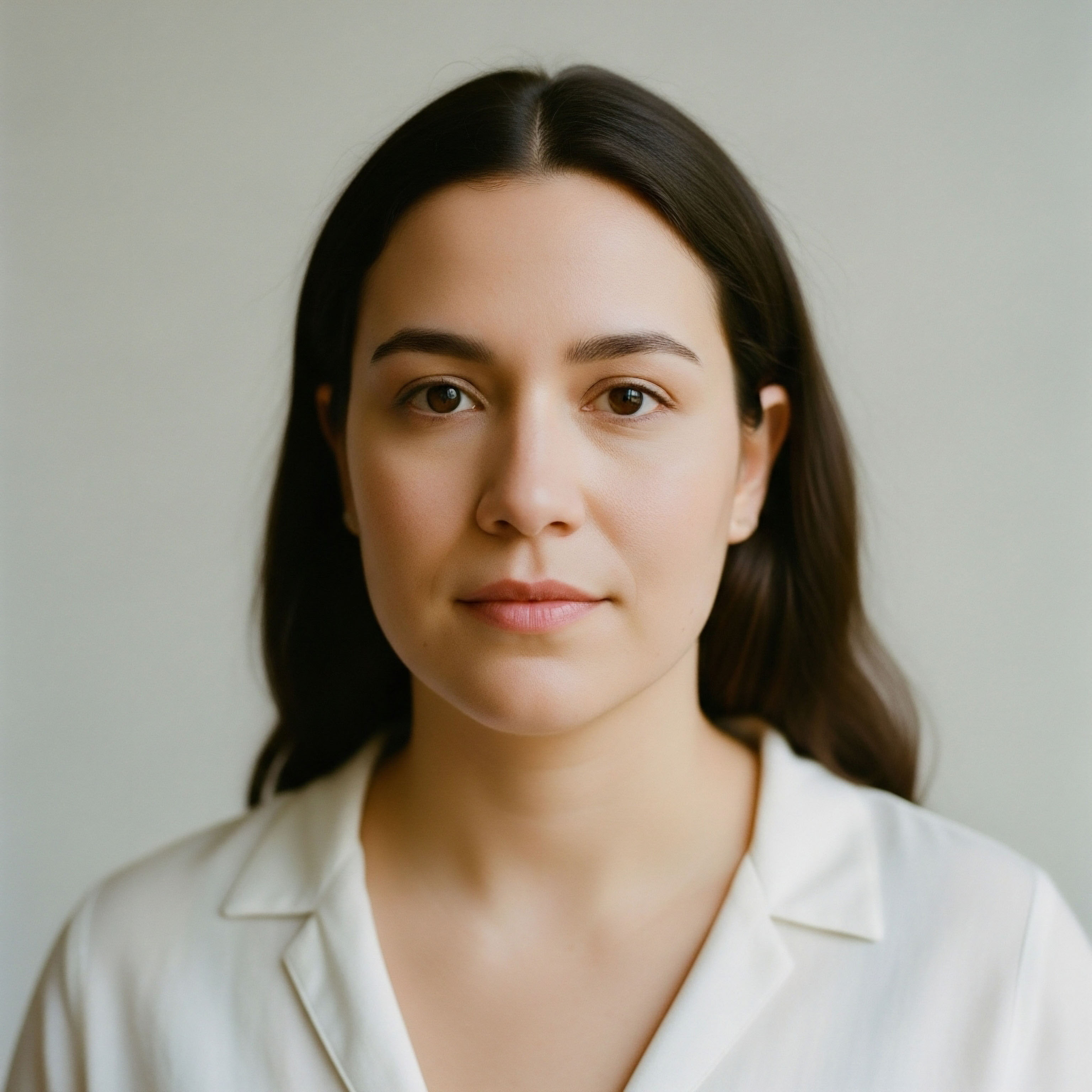

Fundamentals
You have likely noticed changes in your skin over time, a loss of the firmness and bounce it once had. This experience, the tangible feeling of your skin’s texture altering with the years, is a deeply personal one. It is a biological reality rooted in the intricate communication system within your body, orchestrated by hormones.
The question of whether hormonal optimization protocols can improve skin elasticity is not about vanity; it is about understanding and addressing the foundational processes that govern your skin’s health and vitality. Your skin is a direct reflection of your internal hormonal environment. When this environment shifts, particularly with the profound changes of perimenopause and menopause, the structural integrity of your skin changes with it.
The primary architects of your skin’s youthful structure are two proteins ∞ collagen and elastin. Collagen provides the robust framework, the scaffolding that gives skin its thickness and strength. Elastin, as its name suggests, imparts the ability to stretch and snap back. The production and maintenance of this vital matrix are profoundly influenced by your sex hormones.
Estrogen, in particular, is a master regulator of skin health. It directly stimulates fibroblasts, the dermal cells responsible for synthesizing collagen and hyaluronic acid, the molecule that keeps your skin hydrated and plump. When estrogen levels decline, this vital stimulation wanes. The result is a cascade of perceptible changes ∞ skin becomes thinner, drier, and less resilient.
This is a primary reason why, in the first five years following menopause, women can experience a reduction in skin collagen of as much as 30%. This decline is not merely a function of chronological age but is directly correlated with the absence of estrogen.
The decline in estrogen during menopause directly accelerates the loss of skin’s structural proteins, leading to thinning and reduced elasticity.
Testosterone, while present in smaller quantities in women, also plays a crucial role. It contributes to skin thickness and sebum production, which helps maintain the skin’s protective lipid barrier and natural moisture. A balanced hormonal profile, where both estrogen and testosterone are present in optimal ranges, supports a dynamic, healthy skin structure.
The loss of this balance disrupts the skin’s ability to repair itself and maintain its youthful architecture. Hormonal recalibration, therefore, offers a direct intervention. By restoring these crucial signaling molecules, we can re-engage the skin’s innate capacity for regeneration, addressing the biological drivers of visible aging at their source.

The Cellular Reality of Hormonal Decline
To truly grasp how hormonal shifts impact your skin, we need to look at the cellular level. Imagine your skin’s dermis as a bustling construction site. In your younger years, estrogen acts as the project foreman, constantly signaling the fibroblast workers to produce high-quality collagen and elastin.
This ensures the skin’s structural integrity is maintained. With the onset of menopause, the foreman essentially leaves the job site. The fibroblast workers become less active, and the rate of collagen synthesis slows dramatically. Simultaneously, the activity of enzymes that break down collagen, known as matrix metalloproteinases (MMPs), can increase. This combination of decreased production and increased degradation leads to a net loss of dermal thickness and a visible increase in wrinkling and laxity.
This process is not just about appearance. The thinning of the epidermis and dermis compromises the skin’s protective barrier function. The skin becomes more susceptible to environmental damage and shows a reduced capacity for wound healing. The dryness and itching often associated with menopausal skin are direct consequences of a weakened skin barrier and reduced production of hyaluronic acid.
Hormonal optimization protocols work by reintroducing the foreman to the construction site. The renewed presence of estrogen and testosterone signaling reactivates the fibroblasts, stimulating them to once again produce the essential building blocks of healthy skin. This is not a superficial fix; it is a fundamental restoration of cellular function.


Intermediate
Understanding that hormonal decline affects skin elasticity is the first step. The next is to comprehend the specific clinical strategies used to counteract these changes. Hormonal optimization protocols are designed to replenish the body’s levels of key hormones, primarily estrogen and testosterone, to restore physiological function.
These are not one-size-fits-all approaches but are tailored to the individual’s unique biochemistry, symptoms, and health goals. The aim is to re-establish the hormonal balance that supports not just skin health, but overall vitality.
For women, a typical protocol involves the use of bioidentical hormones, which are molecularly identical to those the body naturally produces. Estradiol, the most potent form of estrogen, is a cornerstone of these therapies. It can be administered through various routes, including oral capsules, transdermal patches, or topical creams.
Topical application has the advantage of delivering estrogen directly to the skin, where it can exert its effects locally. Studies have shown that topical estradiol can significantly increase collagen synthesis and dermal thickness in the areas where it is applied. Oral administration provides systemic benefits, impacting all tissues, including the skin. One randomized, double-blind, placebo-controlled trial demonstrated that one year of oral estrogen therapy increased dermal thickness by 30% in postmenopausal women.
Targeted hormonal therapies, including topical and systemic estrogen, have been clinically shown to increase skin thickness and collagen content.
Testosterone is another vital component of a comprehensive hormonal optimization plan for women. While often associated with male physiology, testosterone is essential for female health, contributing to libido, energy levels, and the maintenance of lean muscle mass. In the skin, testosterone supports collagen production and helps maintain its structural integrity.
For women, testosterone is typically prescribed in low doses, often administered via subcutaneous injection or as a topical cream. The combination of estradiol and testosterone can provide synergistic benefits for skin health, addressing both the loss of collagen and the thinning of the dermal layer. Progesterone, another key female hormone, also plays a role.
It helps to balance the effects of estrogen and contributes to skin hydration and elasticity. A well-designed hormonal optimization protocol will consider the interplay of all three of these hormones to create a balanced and effective therapeutic plan.

Comparing Therapeutic Approaches
The choice of hormonal optimization protocol depends on a variety of factors, including the patient’s menopausal status, symptom severity, and personal preferences. Here is a comparison of common therapeutic modalities for women:
| Therapeutic Modality | Mechanism of Action | Primary Benefits for Skin | Considerations |
|---|---|---|---|
| Topical Estradiol/Testosterone Creams | Direct application to the skin allows for localized absorption and action on dermal fibroblasts. | Targeted improvement in skin thickness, collagen, and elastin in the application area. | Effects are primarily localized. Consistent daily application is required. |
| Oral Estradiol/Progesterone | Systemic absorption provides widespread effects throughout the body, including all layers of the skin. | Uniform improvement in skin hydration, thickness, and elasticity across the entire body. | Hormones are processed through the liver (first-pass metabolism), which can affect dosing. |
| Subcutaneous Testosterone Injections | Low-dose injections provide a steady, controlled release of testosterone into the bloodstream. | Supports systemic collagen production and skin thickness, improves energy and libido. | Requires weekly self-administration. Dosing must be carefully monitored to avoid side effects. |
| Testosterone Pellet Therapy | Long-acting pellets implanted under the skin release a consistent dose of testosterone over several months. | Provides sustained hormonal support for skin integrity and overall well-being without the need for frequent dosing. | Requires a minor in-office procedure for insertion. Dosage adjustments are less frequent. |

What Are the Long Term Skin Benefits of HRT?
The long-term benefits of hormonal optimization on the skin are substantial and well-documented. Continuous therapy can significantly slow the rate of collagen loss and skin thinning that occurs after menopause. One study comparing postmenopausal women who had been on long-term oral estrogen therapy with those who had never received it found a significantly lower average wrinkle score in the estrogen-treated group.
This suggests that hormonal support can have a cumulative, protective effect against the visible signs of aging. By maintaining the skin’s structural components and its ability to retain moisture, HRT can help preserve a more youthful appearance for longer. The benefits extend beyond aesthetics; a healthier, thicker skin barrier is more resilient and better able to perform its protective functions.


Academic
A sophisticated understanding of how hormonal optimization improves skin elasticity requires an examination of the molecular and cellular mechanisms at play. The actions of estrogen in the skin are mediated by two distinct nuclear receptors, estrogen receptor alpha (ERα) and estrogen receptor beta (ERβ), as well as a G protein-coupled estrogen receptor (GPER) that mediates rapid, non-genomic effects.
These receptors are expressed in various skin cells, including keratinocytes, fibroblasts, melanocytes, and endothelial cells, indicating the widespread influence of estrogen on skin physiology. The presence and relative abundance of these receptors can vary depending on the cell type and location, which explains the diverse effects of estrogen on the skin.
When estradiol binds to its nuclear receptors in dermal fibroblasts, the receptor-ligand complex translocates to the nucleus and binds to specific DNA sequences known as estrogen response elements (EREs). This interaction modulates the transcription of target genes, including those responsible for the synthesis of type I and type III collagen, as well as elastin.
Clinical studies have provided robust evidence for these effects. A meta-analysis of studies on menopausal hormone therapy (MHT) found that it significantly increases skin elasticity, thickness, and collagen content. Specifically, the analysis reported a standardized mean difference of 2.01 for collagen content in MHT users compared to non-users, a highly significant finding.
Furthermore, estrogen has been shown to down-regulate the expression of matrix metalloproteinases (MMPs), the enzymes responsible for collagen degradation, thus shifting the balance in favor of collagen preservation.

The Role of Androgens and the Hypothalamic-Pituitary-Gonadal Axis
The role of androgens in skin health is complex and often context-dependent. Testosterone can be converted to the more potent androgen, dihydrotestosterone (DHT), by the enzyme 5α-reductase, which is present in the skin. Androgens bind to androgen receptors (ARs), which are also expressed in skin cells.
While high levels of androgens can lead to conditions like acne and hirsutism, optimal levels of testosterone are necessary for maintaining skin health. Testosterone contributes to dermal thickness and has been shown to support collagen synthesis. In women receiving hormonal therapy, the addition of low-dose testosterone can enhance the beneficial effects of estrogen on the skin.
The interplay between estrogens and androgens is a critical aspect of skin homeostasis. Estrogen can counteract some of the less desirable effects of androgens on the skin, such as excessive sebum production.
The regulation of sex hormone production is governed by the hypothalamic-pituitary-gonadal (HPG) axis. The hypothalamus releases gonadotropin-releasing hormone (GnRH), which stimulates the pituitary gland to release luteinizing hormone (LH) and follicle-stimulating hormone (FSH). These hormones, in turn, signal the gonads (ovaries in women, testes in men) to produce estrogen and testosterone.
With age, and particularly during menopause, the responsiveness of the ovaries to LH and FSH declines, leading to a drop in estrogen production. Hormonal optimization protocols that include agents like Gonadorelin, which mimics GnRH, can be used in specific contexts to stimulate the HPG axis and support the body’s natural hormone production pathways. This systems-biology approach, which considers the entire regulatory axis, is fundamental to creating a comprehensive and effective therapeutic plan.

How Does HRT Impact Skin at a Molecular Level?
At the molecular level, hormonal replacement therapy initiates a cascade of events that rejuvenate the skin’s extracellular matrix. The binding of estradiol to its receptors in fibroblasts not only upregulates the genes for collagen and elastin but also increases the production of hyaluronic acid.
This glycosaminoglycan is a powerful humectant, capable of binding and retaining water molecules, which contributes to skin hydration, turgor, and volume. Improved hydration enhances the overall health and appearance of the skin, making it look smoother and more supple. Furthermore, estrogen has been shown to improve cutaneous blood flow by promoting angiogenesis, the formation of new blood vessels.
This enhanced vascularity improves the delivery of oxygen and nutrients to the skin, supporting cellular metabolism and repair processes. The cumulative effect of these molecular changes is a demonstrable improvement in the biomechanical properties of the skin, including its elasticity and resilience.

Evidence from Clinical Trials
The efficacy of hormonal replacement therapy in improving skin elasticity is supported by a growing body of clinical evidence. The following table summarizes key findings from relevant studies:
| Study Type | Intervention | Key Findings | Reference |
|---|---|---|---|
| Systematic Review & Meta-Analysis | Menopausal Hormone Therapy (MHT) | MHT significantly increases skin elasticity, thickness, and collagen content. | |
| Randomized Controlled Trial | Oral Estrogen Therapy (1 year) | Increased dermal thickness by 30% in postmenopausal women. | |
| Randomized Controlled Trial | Topical Estradiol | Increased type I and type III procollagen levels, indicating new collagen synthesis. | |
| Observational Study | Long-term Oral Estrogen | Significantly lower average wrinkle scores in estrogen-treated women compared to non-users. |
- Collagen Synthesis ∞ Estrogen directly stimulates fibroblasts to produce type I and type III collagen, the primary structural proteins of the dermis.
- Elastin Production ∞ Hormonal optimization helps maintain the network of elastin fibers, which are responsible for the skin’s ability to stretch and recoil.
- Hydration ∞ By increasing hyaluronic acid production, estrogen enhances the skin’s ability to retain moisture, leading to a more plump and supple appearance.
- Barrier Function ∞ A thicker, more robust epidermis and dermis improve the skin’s protective barrier, reducing water loss and protecting against environmental damage.

References
- Thornton, M. J. “Estrogens and aging skin.” Dermato-endocrinology, vol. 5, no. 2, 2013, pp. 264-70.
- Pivazyan, L. et al. “Skin Rejuvenation in Women using Menopausal Hormone Therapy ∞ A Systematic Review and Meta-Analysis.” Journal of Menopausal Medicine, vol. 29, no. 3, 2023, pp. 97-111.
- Moy, L. and R. Moy. “HRT for anti-aging ∞ The hormones and the benefits.” Dermatology Times, 14 Oct. 2019.
- Verdier-Sévrain, S. et al. “Biology of estrogens in skin ∞ implications for skin aging.” Experimental Dermatology, vol. 15, no. 2, 2006, pp. 83-94.
- Wilkinson, H. N. and M. J. Hardman. “The role of estrogen in cutaneous ageing and repair.” Maturitas, vol. 103, 2017, pp. 60-64.

Reflection
The information presented here offers a window into the intricate relationship between your internal hormonal milieu and the health of your skin. Understanding these biological connections is a powerful act of self-awareness. It moves the conversation about skin aging from a narrative of inevitable decline to one of proactive management.
The decision to explore hormonal optimization is a personal one, a step on a larger path toward understanding your own unique physiology. This knowledge is the foundation upon which you can build a personalized wellness strategy, one that aligns with your body’s specific needs and your long-term health objectives. Your journey is your own, and it begins with the recognition that you have the capacity to actively participate in your own well-being.



